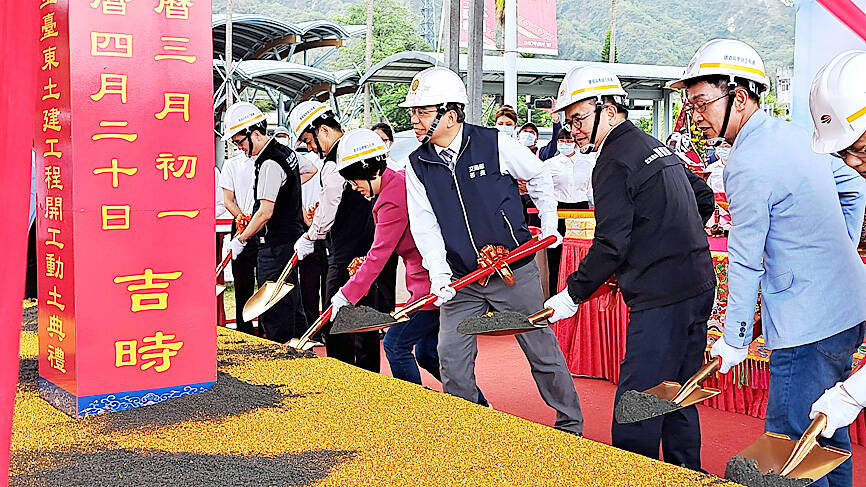The Ministry of Transportation and Communications (MOTC) on Thursday held a groundbreaking ceremony for a planned dual-track electrified rail line at Taitung Station.
The first phase of the project would connect Taitung City with Taitung County’s Jhihben Township (知本), the Railway Bureau said in a statement.
The connection is part of a larger project to modernize the rail link between Hualien City and Taitung, it said, adding that the dual-track electrified railway would allow trains to run more efficiently and handle peak-time passenger volumes more easily.

Photo: Huang Ming-tang, Taipei Times
After all single-track sections on the route from Kaohsiung to Hualien are updated, trains would be able to cover the distance in three hours, it said.
The project is expected to cost NT$45.6 billion (US$1.49 billion) and be finished in October 2027, when construction crews from the north and south are scheduled to meet 112.6km south of Hualien Station, the bureau said.
Faster travel on the route would boost tourism and make commuting easier for Taitung residents, it added.
Democratic Progressive Party Legislator Liu Chao-hao (劉櫂豪) told the event that up to eight train services per hour would be offered on the route.
Peak-time tickets would no longer sell out far in advance, Liu said, adding that the issue has for a long time been an annoyance to visitors and residents.
The ministry has also purchased 50 Hitachi EMU3000 inter-city trains and hired additional drivers to address the issue, Liu added.
Minister of Transportation and Communications Wang Kwo-tsai (王國材) said that after the dual-track project and planned high-speed rail links are finished, it would be possible to travel around Taiwan proper in six hours.

SHIPS, TRAINS AND AUTOMOBILES: The ministry has announced changes to varied transportation industries taking effect soon, with a number of effects for passengers Beginning next month, the post office is canceling signature upon delivery and written inquiry services for international registered small packets in accordance with the new policy of the Universal Postal Union, the Ministry of Transportation and Communications said yesterday. The new policy does not apply to packets that are to be delivered to China, the ministry said. Senders of international registered small packets would receive a NT$10 rebate on postage if the packets are sent from Jan. 1 to March 31, it added. The ministry said that three other policies are also scheduled to take effect next month. International cruise ship operators

HORROR STORIES: One victim recounted not realizing they had been stabbed and seeing people bleeding, while another recalled breaking down in tears after fleeing A man on Friday died after he tried to fight the knife-wielding suspect who went on a stabbing spree near two of Taipei’s busiest metro stations, Taipei Mayor Chiang Wan-an (蔣萬安) said. The 57-year-old man, identified by his family name, Yu (余), encountered the suspect at Exit M7 of Taipei Main Station and immediately tried to stop him, but was fatally wounded and later died, Chiang said, calling the incident “heartbreaking.” Yu’s family would receive at least NT$5 million (US$158,584) in compensation through the Taipei Rapid Transit Corp’s (TRTC) insurance coverage, he said after convening an emergency security response meeting yesterday morning. National

PLANNED: The suspect visited the crime scene before the killings, seeking information on how to access the roof, and had extensively researched a 2014 stabbing incident The suspect in a stabbing attack that killed three people and injured 11 in Taipei on Friday had planned the assault and set fires at other locations earlier in the day, law enforcement officials said yesterday. National Police Agency (NPA) Director-General Chang Jung-hsin (張榮興) said the suspect, a 27-year-old man named Chang Wen (張文), began the attacks at 3:40pm, first setting off smoke bombs on a road, damaging cars and motorbikes. Earlier, Chang Wen set fire to a rental room where he was staying on Gongyuan Road in Zhongzheng District (中正), Chang Jung-hsin said. The suspect later threw smoke grenades near two exits

The Forestry and Nature Conservation Agency yesterday launched a gift box to market honey “certified by a Formosan black bear” in appreciation of a beekeeper’s amicable interaction with a honey-thieving bear. Beekeeper Chih Ming-chen (池明鎮) in January inspected his bee farm in Hualien County’s Jhuosi Township (卓溪) and found that more than 20 beehives had been destroyed and many hives were eaten, with bear droppings and paw prints near the destroyed hives, the agency said. Chih returned to the farm to move the remaining beehives away that evening when he encountered a Formosan black bear only 20m away, the agency said. The bear